Abstract
The effects of heat and chemical inactivation on the antigenicity and immunogenicity of Vibrio cholerae 1418 in rabbits were studied. V. cholerae 1418 was inactivated with heat and chemical inactivants (phenol or Formalin) alone or in combination. Enzyme-linked immunoassay systems employing whole cells of V. cholerae 1418, lipopolysaccharide, or flagella as immobilized antigens were used to measure the antibody response (immunoglobulins G and M) after parenteral immunization of rabbits with various inactivated whole-cell preparations. The "classical" whole-cell vaccine, produced by phenol treatment, was found to be a comparatively poor immunogen. When Formalin was used instead of phenol, the antibody response to all three enzyme-linked immunosorbent assay antigens was greatly increased. Immunoglobulin G titers to intact V. cholerae cells were as much as 100-fold higher in rabbits immunized with the Formalin-inactivated preparation as compared to the classical phenol-inactivated vaccine. Furthermore, antibody produced against the Formalin-inactivated preparation was capable of recognizing antigenic determinants expressed on the cell surface of several heterologous strains of V. cholerae. These results indicate that the antigenicity and immunogenicity of V. cholerae are greatly affected by the inactivation conditions employed for vaccine production and that Formalin is much superior to phenol as an inactivant under the conditions employed in the present study.
Full text
PDF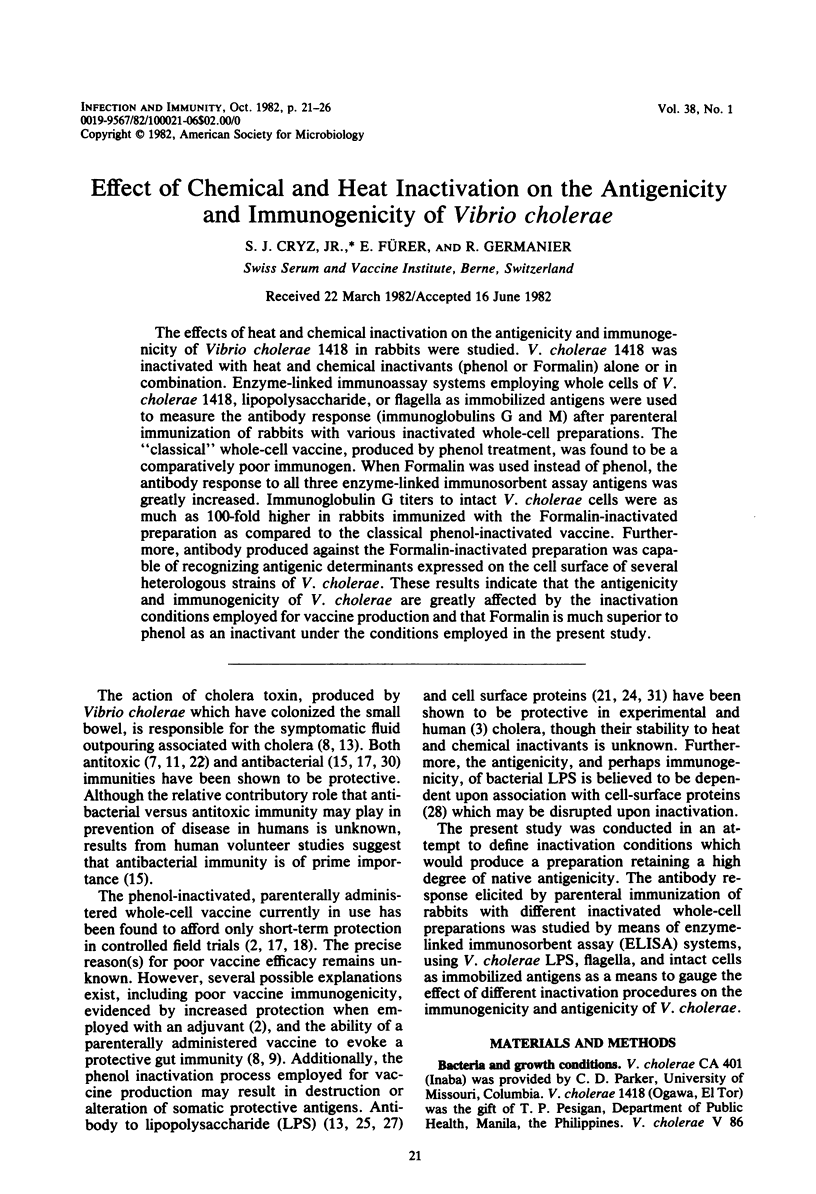
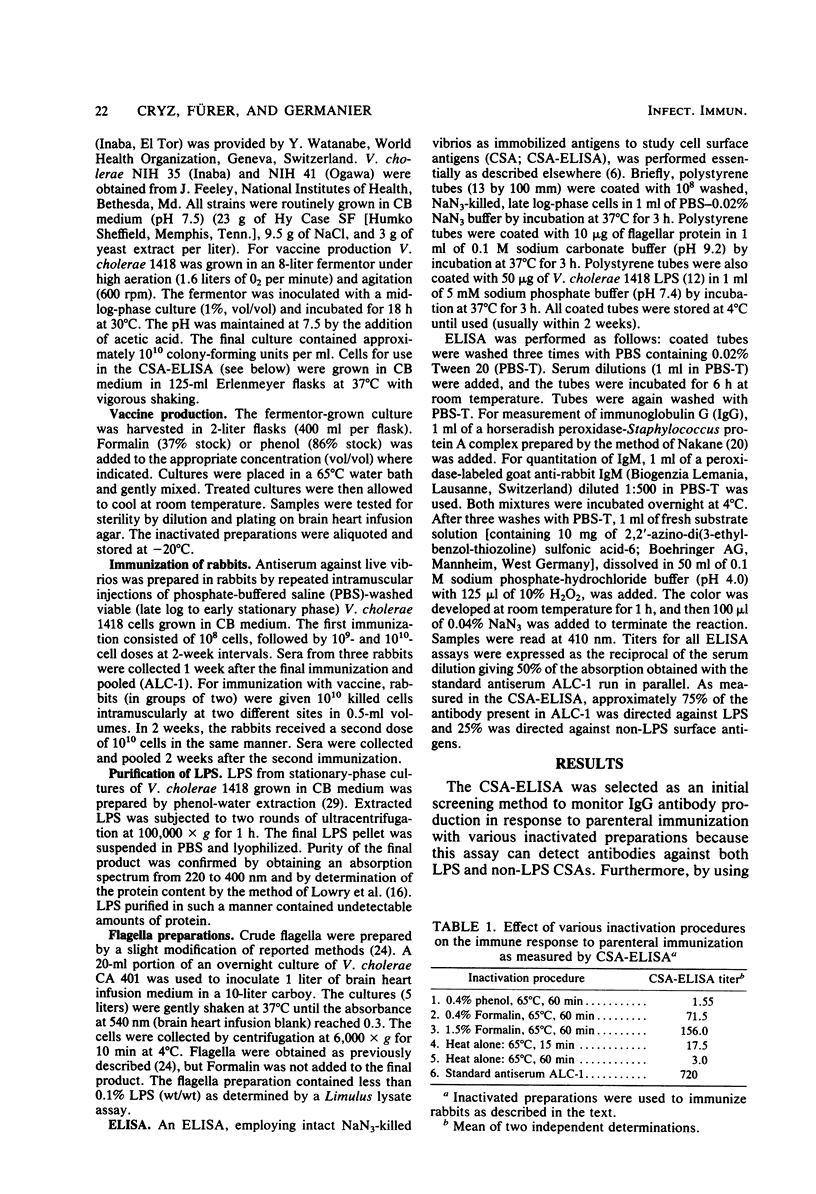

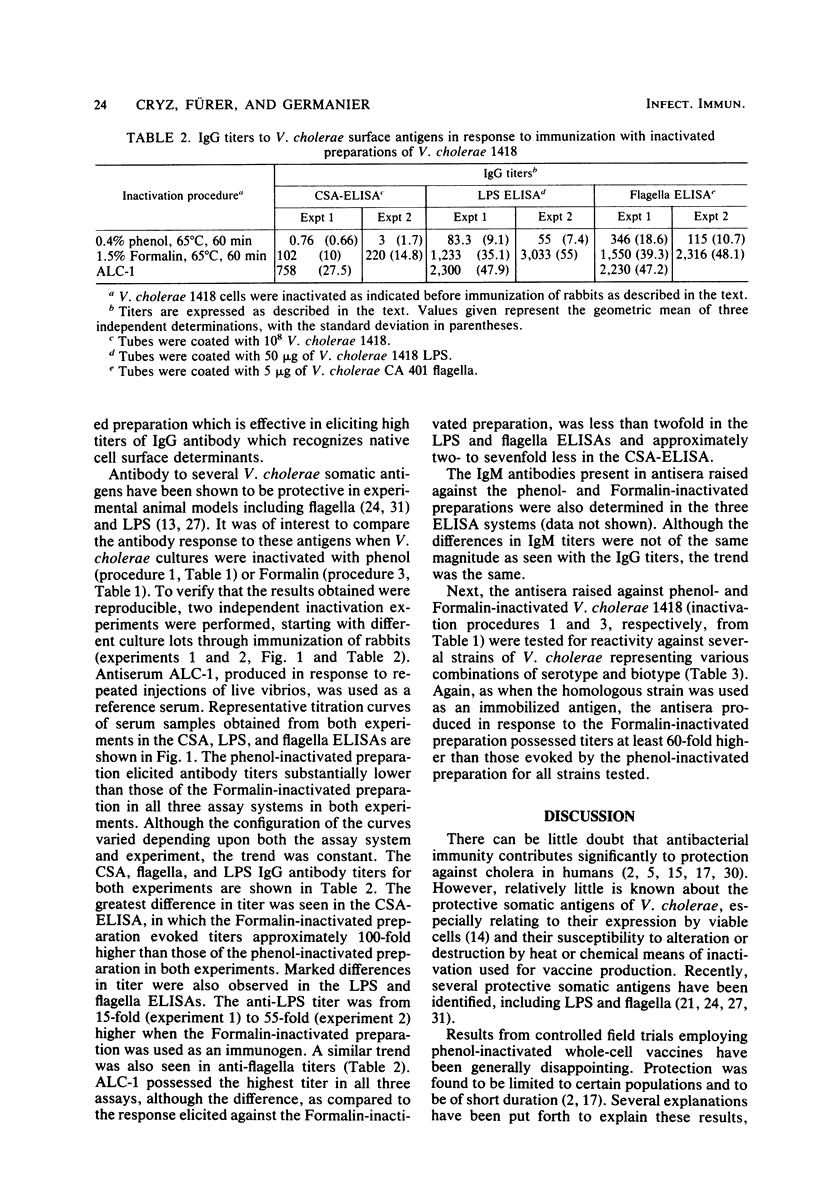
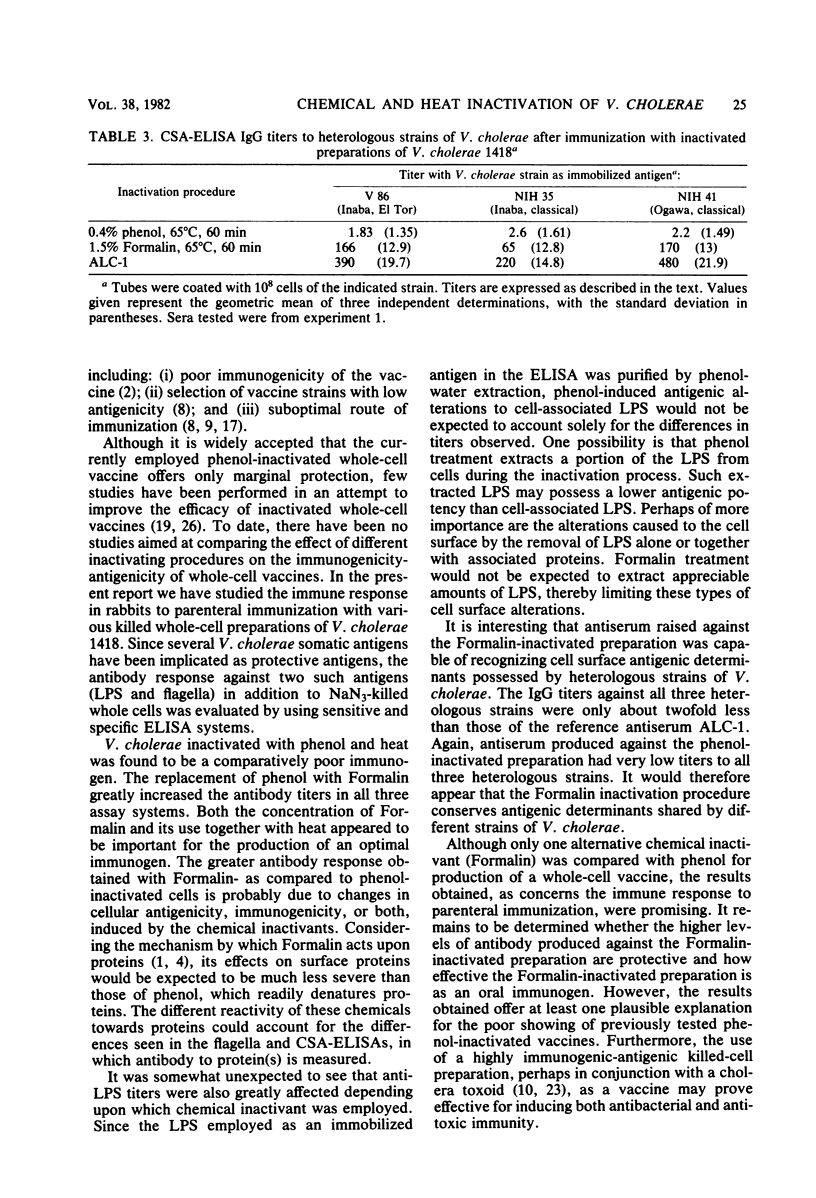
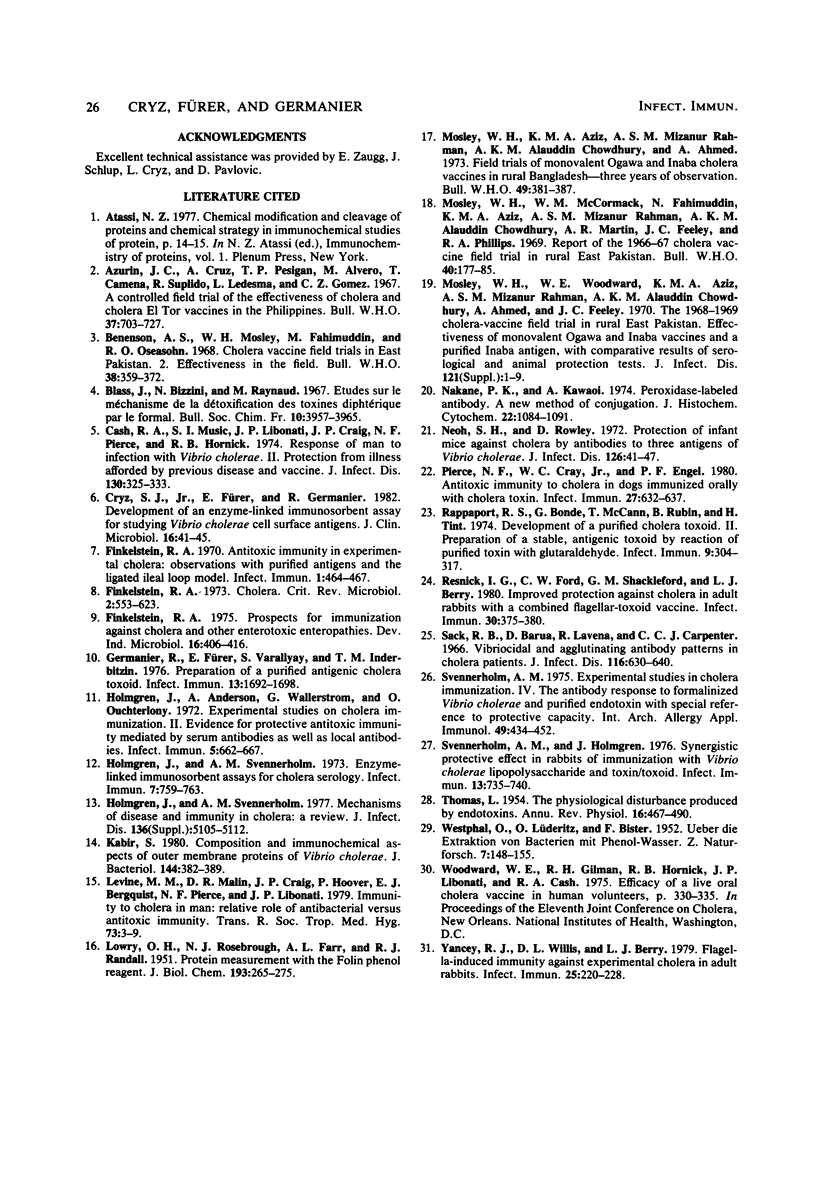
Selected References
These references are in PubMed. This may not be the complete list of references from this article.
- Azurin J. C., Cruz A., Pesigan T. P., Alvero M., Camena T., Suplido R., Ledesma L., Gomez C. Z. A controlled field trial of the effectiveness of cholera and cholera El Tor vaccines in the Philippines. Bull World Health Organ. 1967;37(5):703–727. [PMC free article] [PubMed] [Google Scholar]
- Benenson A. S., Mosley W. H., Fahimuddin M., Oseasohn R. O. Cholera vaccine field trials in east Pakistan. 2. Effectiveness in the field. Bull World Health Organ. 1968;38(3):359–372. [PMC free article] [PubMed] [Google Scholar]
- Cash R. A., Music S. I., Libonati J. P., Craig J. P., Pierce N. F., Hornick R. B. Response of man to infection with Vibrio cholerae. II. Protection from illness afforded by previous disease and vaccine. J Infect Dis. 1974 Oct;130(4):325–333. doi: 10.1093/infdis/130.4.325. [DOI] [PubMed] [Google Scholar]
- Cryz S. J., Jr, Fürer E., Germanier R. Development of an enzyme-linked immunosorbent assay for studying Vibrio cholerae cell surface antigens. J Clin Microbiol. 1982 Jul;16(1):41–45. doi: 10.1128/jcm.16.1.41-45.1982. [DOI] [PMC free article] [PubMed] [Google Scholar]
- Finkelstein R. A. Antitoxic immunity in experimental cholera: observations with purified antigens and the ligated ileal loop model. Infect Immun. 1970 May;1(5):464–467. doi: 10.1128/iai.1.5.464-467.1970. [DOI] [PMC free article] [PubMed] [Google Scholar]
- Germanier R., Fürer E., Varallyay S., Inderbitzin T. M. Preparation of a purified antigenic cholera toxoid. Infect Immun. 1976 Jun;13(6):1692–1698. doi: 10.1128/iai.13.6.1692-1698.1976. [DOI] [PMC free article] [PubMed] [Google Scholar]
- Holmgren J., Andersson A., Wallerstrom G., Ouchterlony O. Experimental studies on cholera immunization. II. Evidence for protective antitoxic immunity mediated by serum antibodies as well as local antibodies. Infect Immun. 1972 May;5(5):662–667. doi: 10.1128/iai.5.5.662-667.1972. [DOI] [PMC free article] [PubMed] [Google Scholar]
- Holmgren J., Svennerholm A. M. Enzyme-linked immunosorbent assays for cholera serology. Infect Immun. 1973 May;7(5):759–763. doi: 10.1128/iai.7.5.759-763.1973. [DOI] [PMC free article] [PubMed] [Google Scholar]
- Kabir S. Composition and immunochemical properties of outer membrane proteins of Vibrio cholerae. J Bacteriol. 1980 Oct;144(1):382–389. doi: 10.1128/jb.144.1.382-389.1980. [DOI] [PMC free article] [PubMed] [Google Scholar]
- LOWRY O. H., ROSEBROUGH N. J., FARR A. L., RANDALL R. J. Protein measurement with the Folin phenol reagent. J Biol Chem. 1951 Nov;193(1):265–275. [PubMed] [Google Scholar]
- Levine M. M., Nalin D. R., Craig J. P., Hoover D., Bergquist E. J., Waterman D., Holley H. P., Hornick R. B., Pierce N. P., Libonati J. P. Immunity of cholera in man: relative role of antibacterial versus antitoxic immunity. Trans R Soc Trop Med Hyg. 1979;73(1):3–9. doi: 10.1016/0035-9203(79)90119-6. [DOI] [PubMed] [Google Scholar]
- Mosley W. H., Aziz K. M., Rahman A. S., Chowdhury A. K., Ahmed A. Field trials of monovalent Ogawa and Inaba cholera vaccines in rural Bangladesh--three years of observation. Bull World Health Organ. 1973;49(4):381–387. [PMC free article] [PubMed] [Google Scholar]
- Mosley W. H., McCormack W. M., Fahimuddin M., Aziz K. M., Rahman A. S., Chowdhury A. K., Martin A. R., Feeley J. C., Phillips R. A. Report of the 1966-67 cholera vaccine field trial in rural East Pakistan. I. Study design and results of the first year of observation. Bull World Health Organ. 1969;40(2):177–185. [PMC free article] [PubMed] [Google Scholar]
- Mosley W. H., Woodward W. E., Aziz K. M., Rahman A. S., Chowdhury A. K., Ahmed A., Feeley J. C. The 1968-1969 cholera-vaccine field trial in rural East Pakistan. Effectiveness of monovalent Ogawa and Inaba vaccines and a purified Inaba antigen, with comparative results of serological and animal protection tests. J Infect Dis. 1970 May;121(Suppl):1–9. doi: 10.1093/infdis/121.supplement.s1. [DOI] [PubMed] [Google Scholar]
- Nakane P. K., Kawaoi A. Peroxidase-labeled antibody. A new method of conjugation. J Histochem Cytochem. 1974 Dec;22(12):1084–1091. doi: 10.1177/22.12.1084. [DOI] [PubMed] [Google Scholar]
- Neoh S. H., Rowley D. Protection of infant mice against cholera by antibodies to three antigens of Vibrio cholerae. J Infect Dis. 1972 Jul;126(1):41–47. doi: 10.1093/infdis/126.1.41. [DOI] [PubMed] [Google Scholar]
- Pierce N. F., Cray W. C., Jr, Engel P. F. Antitoxic immunity to cholera in dogs immunized orally with cholera toxin. Infect Immun. 1980 Feb;27(2):632–637. doi: 10.1128/iai.27.2.632-637.1980. [DOI] [PMC free article] [PubMed] [Google Scholar]
- Rappaport R. S., Bonde G., McCann T., Rubin B. A., Tint H. Development of a purified cholera toxoid. II. Preparation of a stable, antigenic toxoid by reaction of purified toxin with glutaraldehyde. Infect Immun. 1974 Feb;9(2):304–317. doi: 10.1128/iai.9.2.304-317.1974. [DOI] [PMC free article] [PubMed] [Google Scholar]
- Resnick I. G., Ford C. W., Shackleford G. M., Berry L. J. Improved protection against cholera in adult rabbits with a combined flagellar-toxoid vaccine. Infect Immun. 1980 Nov;30(2):375–380. doi: 10.1128/iai.30.2.375-380.1980. [DOI] [PMC free article] [PubMed] [Google Scholar]
- Sack R. B., Barua D., Saxena R., Carpenter C. C. Vibriocidal and agglutinating antibody patterns in cholera patients. J Infect Dis. 1966 Dec;116(5):630–640. doi: 10.1093/infdis/116.5.630. [DOI] [PubMed] [Google Scholar]
- Svennerholm A. M. Experimental studies on cholera immunization. 4. The antibody response to formalinized Vibrio cholerae and purified endotoxin with special reference to protective capacity. Int Arch Allergy Appl Immunol. 1975;49(4):434–452. [PubMed] [Google Scholar]
- Svennerholm A. M., Holmgren J. Synergistic protective effect in rabbits of immunization with Vibrio cholerae lipopolysaccharide and toxin/toxoid. Infect Immun. 1976 Mar;13(3):735–740. doi: 10.1128/iai.13.3.735-740.1976. [DOI] [PMC free article] [PubMed] [Google Scholar]
- THOMAS L. The physiological disturbances produced by endotoxins. Annu Rev Physiol. 1954;16:467–490. doi: 10.1146/annurev.ph.16.030154.002343. [DOI] [PubMed] [Google Scholar]
- Yancey R. J., Willis D. L., Berry L. J. Flagella-induced immunity against experimental cholera in adult rabbits. Infect Immun. 1979 Jul;25(1):220–228. doi: 10.1128/iai.25.1.220-228.1979. [DOI] [PMC free article] [PubMed] [Google Scholar]


